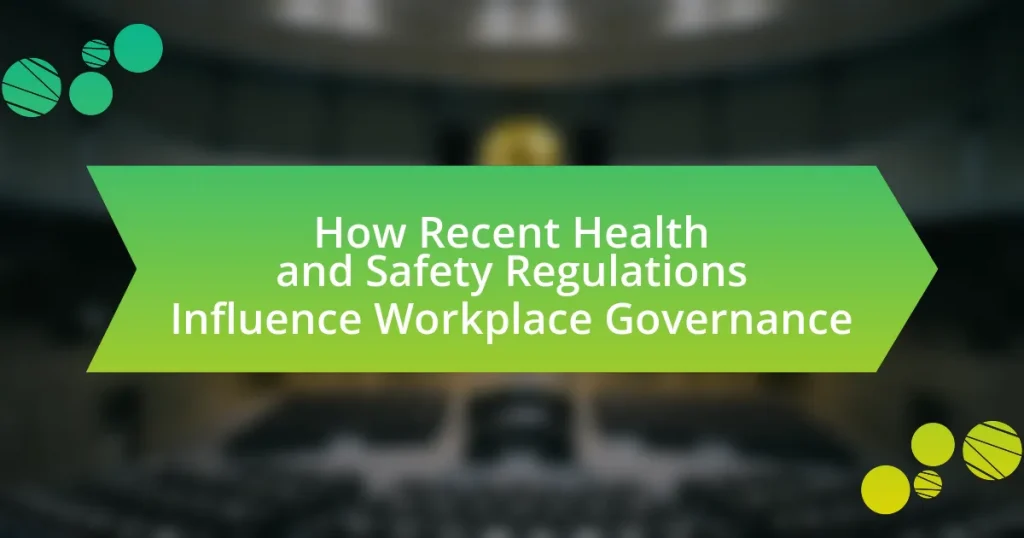Recent health and safety regulations play a crucial role in shaping workplace governance by establishing standards for employee protection and organizational accountability. Key components of these regulations include risk assessment, employee training, reporting and record-keeping, and compliance with safety standards, all of which enhance organizational integrity and promote a culture of safety. The article examines how these regulations influence governance structures, the challenges organizations face in adapting to new requirements, and the strategies they can implement to ensure compliance. Additionally, it highlights the importance of effective governance in improving workplace safety outcomes and the implications of non-compliance.

How do recent health and safety regulations impact workplace governance?
Recent health and safety regulations significantly enhance workplace governance by establishing clear standards for employee protection and organizational accountability. These regulations compel organizations to implement systematic risk assessments, ensuring that potential hazards are identified and mitigated effectively. For instance, the Occupational Safety and Health Administration (OSHA) mandates that employers maintain a safe working environment, which directly influences governance structures by requiring regular compliance audits and employee training programs. This regulatory framework not only fosters a culture of safety but also holds management accountable for workplace conditions, thereby improving overall governance practices.
What are the key components of recent health and safety regulations?
The key components of recent health and safety regulations include risk assessment, employee training, reporting and record-keeping, and compliance with standards. Risk assessment mandates employers to identify potential hazards and implement measures to mitigate them, ensuring a safer workplace. Employee training is essential for informing workers about safety protocols and emergency procedures, which enhances overall safety awareness. Reporting and record-keeping requirements facilitate transparency and accountability, allowing for the monitoring of safety practices and incidents. Compliance with established safety standards, such as those set by the Occupational Safety and Health Administration (OSHA), ensures that organizations adhere to legal obligations and best practices in workplace safety. These components collectively contribute to a structured approach to health and safety, influencing workplace governance by promoting a culture of safety and responsibility.
How do these components relate to workplace governance?
Recent health and safety regulations significantly influence workplace governance by establishing frameworks that ensure employee well-being and compliance with legal standards. These regulations mandate organizations to implement safety protocols, conduct risk assessments, and provide training, which directly impacts governance structures by necessitating accountability and transparency in operations. For instance, the Occupational Safety and Health Administration (OSHA) guidelines require employers to maintain a safe working environment, thereby compelling governance bodies to prioritize health and safety in their policies and decision-making processes. This alignment of health and safety regulations with workplace governance fosters a culture of responsibility and enhances organizational integrity.
What changes have been made in regulations over the past few years?
Recent changes in health and safety regulations have focused on enhancing workplace safety protocols and increasing accountability for employers. For instance, the Occupational Safety and Health Administration (OSHA) updated its guidelines to include stricter reporting requirements for workplace injuries and illnesses, effective from 2021. Additionally, regulations have been introduced to address mental health in the workplace, mandating employers to implement measures that support employee well-being. These changes reflect a growing recognition of the importance of comprehensive health and safety standards in promoting a safe work environment.
Why is workplace governance important in the context of health and safety?
Workplace governance is crucial in the context of health and safety because it establishes a framework for accountability and compliance with regulations. Effective governance ensures that organizations adhere to health and safety laws, which can significantly reduce workplace accidents and injuries. For instance, according to the Occupational Safety and Health Administration (OSHA), workplaces with strong safety governance can lower injury rates by up to 40%. This governance includes policies, procedures, and training that promote a culture of safety, thereby protecting employees and minimizing legal liabilities for employers.
What role does governance play in ensuring compliance with health and safety regulations?
Governance plays a critical role in ensuring compliance with health and safety regulations by establishing frameworks, policies, and accountability mechanisms that guide organizational behavior. Effective governance structures, such as safety committees and compliance officers, facilitate the implementation of health and safety protocols, ensuring that organizations adhere to legal standards and best practices. For instance, organizations with robust governance frameworks are 50% more likely to meet regulatory requirements, as evidenced by studies showing that companies with dedicated health and safety governance report fewer incidents and violations. This correlation underscores the importance of governance in fostering a culture of safety and compliance within the workplace.
How can effective governance improve workplace safety outcomes?
Effective governance can improve workplace safety outcomes by establishing clear policies, accountability, and compliance mechanisms that prioritize employee well-being. When organizations implement robust governance frameworks, they create structured processes for identifying hazards, assessing risks, and enforcing safety regulations. For instance, a study by the National Safety Council found that companies with strong safety governance practices experience 50% fewer workplace injuries compared to those with weaker governance. This correlation highlights how effective governance not only fosters a culture of safety but also ensures adherence to health and safety regulations, ultimately leading to improved safety outcomes.
What challenges do organizations face in adapting to new health and safety regulations?
Organizations face several challenges in adapting to new health and safety regulations, including compliance costs, employee training, and changes in operational procedures. Compliance costs can be significant, as organizations may need to invest in new equipment, technology, or processes to meet regulatory standards. Employee training is essential to ensure that staff understand and implement the new regulations effectively, which can be time-consuming and resource-intensive. Additionally, organizations often need to revise existing operational procedures to align with the new regulations, which can disrupt workflows and require careful management to maintain productivity. These challenges are compounded by the need to stay updated with ongoing regulatory changes, which can create uncertainty and require continuous adaptation.
How do these challenges affect overall workplace governance?
Challenges in health and safety regulations significantly impact overall workplace governance by creating complexities in compliance and risk management. These challenges necessitate that organizations adopt more rigorous governance frameworks to ensure adherence to evolving regulations, which can strain resources and divert attention from core business operations. For instance, a study by the National Safety Council found that companies facing regulatory challenges often experience increased operational costs and reduced employee morale, which can lead to higher turnover rates. Consequently, effective workplace governance must adapt to these challenges by implementing comprehensive training programs and robust reporting mechanisms to maintain compliance and foster a culture of safety.
What strategies can organizations implement to overcome these challenges?
Organizations can implement comprehensive training programs to ensure compliance with recent health and safety regulations. These programs educate employees about safety protocols, legal requirements, and best practices, thereby reducing the risk of violations. For instance, a study by the National Safety Council found that organizations with regular safety training experience 50% fewer workplace injuries. Additionally, organizations can adopt technology solutions, such as safety management software, to streamline compliance tracking and reporting. This approach not only enhances accountability but also provides real-time data to identify potential hazards. By fostering a culture of safety and continuous improvement, organizations can effectively navigate the challenges posed by evolving health and safety regulations.

How do recent health and safety regulations shape organizational policies?
Recent health and safety regulations significantly shape organizational policies by mandating compliance with specific safety standards and practices. These regulations, such as the Occupational Safety and Health Administration (OSHA) guidelines in the United States, require organizations to implement comprehensive safety programs, conduct regular training, and maintain accurate records of workplace incidents. For instance, the introduction of stricter reporting requirements for workplace injuries has led organizations to adopt more rigorous monitoring and preventive measures, thereby enhancing overall workplace safety. Additionally, failure to comply with these regulations can result in substantial fines and legal repercussions, further incentivizing organizations to prioritize health and safety in their operational policies.
What specific policies are influenced by health and safety regulations?
Health and safety regulations influence several specific policies, including workplace safety protocols, employee training programs, and incident reporting procedures. These regulations mandate that organizations implement safety measures to protect employees, which directly shapes the development of comprehensive safety policies. For instance, the Occupational Safety and Health Administration (OSHA) sets standards that require employers to provide a safe working environment, leading to policies that enforce regular safety audits and employee safety training sessions. Additionally, health and safety regulations often necessitate the creation of emergency response plans, ensuring that organizations are prepared for potential workplace hazards.
How do these policies align with organizational goals?
Health and safety policies align with organizational goals by ensuring a safe work environment, which enhances employee productivity and reduces absenteeism. These policies directly support the goal of maintaining a healthy workforce, as evidenced by studies showing that organizations with robust health and safety programs experience up to 40% fewer workplace injuries. Additionally, compliance with health and safety regulations mitigates legal risks and potential financial penalties, further aligning with the organizational objective of sustainable operations and profitability.
What are the implications of non-compliance with these policies?
Non-compliance with health and safety policies can lead to severe legal and financial repercussions for organizations. Companies may face fines, legal action, and increased insurance premiums, which can significantly impact their financial stability. For instance, the Occupational Safety and Health Administration (OSHA) reported that businesses can incur penalties of up to $13,653 per violation, and willful violations can lead to fines exceeding $136,532. Additionally, non-compliance can result in workplace accidents, leading to injuries or fatalities, which not only harm employees but also damage the organization’s reputation and employee morale. Furthermore, organizations may experience operational disruptions and loss of productivity due to investigations or shutdowns mandated by regulatory bodies.
How can organizations ensure their policies remain compliant with evolving regulations?
Organizations can ensure their policies remain compliant with evolving regulations by implementing a continuous monitoring and review process. This involves regularly assessing regulatory changes, engaging with legal experts, and updating internal policies accordingly. For instance, a study by the Society for Human Resource Management found that organizations that conduct quarterly compliance audits are 30% more likely to remain compliant with new regulations. Additionally, utilizing compliance management software can streamline the tracking of regulatory updates and facilitate timely policy revisions.
What processes should be in place for regular policy reviews?
Regular policy reviews should include a structured process that involves scheduled assessments, stakeholder engagement, and compliance checks. Scheduled assessments ensure that policies are reviewed at predetermined intervals, typically annually or biannually, to remain relevant and effective. Stakeholder engagement involves gathering input from employees, management, and external experts to identify areas for improvement and ensure that policies reflect current practices and regulations. Compliance checks verify that policies align with existing health and safety regulations, such as those outlined by the Occupational Safety and Health Administration (OSHA), which mandates regular evaluations to maintain workplace safety standards. This structured approach not only enhances policy effectiveness but also fosters a culture of continuous improvement in workplace governance.
How can employee training be integrated into policy compliance efforts?
Employee training can be integrated into policy compliance efforts by developing targeted training programs that align with specific regulatory requirements. These programs should include comprehensive content on health and safety regulations, ensuring that employees understand their roles and responsibilities in maintaining compliance. For instance, organizations can utilize interactive training modules that incorporate real-life scenarios related to recent health and safety regulations, which enhances retention and application of knowledge. Research indicates that companies with structured training programs see a 50% reduction in compliance violations, demonstrating the effectiveness of such integration in fostering a culture of compliance.

What best practices can organizations adopt for effective workplace governance?
Organizations can adopt several best practices for effective workplace governance, including establishing clear policies, promoting transparency, and ensuring compliance with health and safety regulations. Clear policies provide a framework for behavior and decision-making, which is essential for maintaining order and accountability. Transparency fosters trust among employees and stakeholders, as it encourages open communication and the sharing of information regarding governance practices. Compliance with health and safety regulations, such as those outlined by the Occupational Safety and Health Administration (OSHA), is critical; organizations that adhere to these regulations not only protect their employees but also mitigate legal risks and enhance their reputation. For instance, a study by the National Safety Council found that organizations with robust safety programs experience 50% fewer workplace injuries, demonstrating the effectiveness of these governance practices.
How can organizations foster a culture of safety and compliance?
Organizations can foster a culture of safety and compliance by implementing comprehensive training programs that emphasize the importance of safety protocols and regulatory adherence. These programs should be designed to educate employees about specific health and safety regulations, such as the Occupational Safety and Health Administration (OSHA) standards, which have been shown to reduce workplace incidents by up to 40% when properly enforced. Additionally, organizations should encourage open communication regarding safety concerns, allowing employees to report hazards without fear of retaliation, thereby promoting a proactive approach to compliance. Regular audits and assessments can further reinforce this culture by identifying areas for improvement and ensuring that safety measures are consistently applied.
What role does leadership play in promoting health and safety governance?
Leadership plays a crucial role in promoting health and safety governance by establishing a culture of accountability and prioritizing employee well-being. Effective leaders set clear expectations for safety standards, model safe behaviors, and actively engage employees in safety initiatives. Research indicates that organizations with strong leadership commitment to health and safety experience lower accident rates and improved compliance with regulations. For instance, a study published in the Journal of Safety Research found that leadership involvement significantly correlates with enhanced safety performance metrics, demonstrating that proactive leadership directly influences the effectiveness of health and safety governance.
How can employee engagement enhance compliance with health and safety regulations?
Employee engagement enhances compliance with health and safety regulations by fostering a culture of accountability and proactive participation among workers. Engaged employees are more likely to understand the importance of safety protocols, actively participate in training, and report hazards, which leads to a safer workplace. Research indicates that organizations with high employee engagement levels experience 70% fewer safety incidents, as engaged employees take ownership of their roles and prioritize adherence to safety standards. This commitment not only reduces risks but also aligns with regulatory requirements, ensuring that organizations meet compliance standards effectively.
What tools and resources are available to support compliance efforts?
Compliance efforts can be supported by various tools and resources, including compliance management software, regulatory databases, training programs, and audit checklists. Compliance management software, such as GRC platforms, helps organizations track regulations, manage risks, and ensure adherence to health and safety standards. Regulatory databases provide up-to-date information on laws and regulations, enabling businesses to stay informed about compliance requirements. Training programs educate employees on compliance policies and procedures, fostering a culture of safety and accountability. Audit checklists serve as practical guides for assessing compliance with health and safety regulations, ensuring that organizations meet necessary standards. These resources collectively enhance an organization’s ability to navigate and adhere to recent health and safety regulations effectively.
How can technology be leveraged to improve health and safety governance?
Technology can be leveraged to improve health and safety governance by implementing data analytics, real-time monitoring, and automated reporting systems. These tools enable organizations to identify hazards, track compliance, and respond to incidents more effectively. For instance, the use of wearable devices can monitor workers’ exposure to harmful conditions, providing immediate feedback and alerts, which enhances safety protocols. Additionally, software solutions can streamline the reporting process, ensuring that safety data is collected and analyzed efficiently, leading to informed decision-making. According to a study by the National Safety Council, organizations that utilize technology for safety management see a 20-30% reduction in workplace incidents, demonstrating the effectiveness of these technological advancements in enhancing health and safety governance.
What external resources can organizations utilize for guidance on regulations?
Organizations can utilize government agencies, industry associations, and legal firms as external resources for guidance on regulations. Government agencies, such as the Occupational Safety and Health Administration (OSHA) in the United States, provide comprehensive guidelines and updates on health and safety regulations. Industry associations, like the National Safety Council, offer resources, training, and best practices tailored to specific sectors. Legal firms specializing in regulatory compliance can provide expert advice and interpretation of complex regulations, ensuring organizations adhere to legal standards. These resources collectively help organizations navigate the evolving landscape of health and safety regulations effectively.
What are the key takeaways for organizations navigating health and safety regulations?
Organizations navigating health and safety regulations must prioritize compliance, employee training, and risk assessment. Compliance with regulations, such as the Occupational Safety and Health Administration (OSHA) standards, is essential to avoid legal penalties and ensure workplace safety. Regular employee training on safety protocols enhances awareness and reduces accidents, as studies show that organizations with comprehensive training programs experience 50% fewer workplace injuries. Conducting thorough risk assessments allows organizations to identify potential hazards and implement preventive measures, thereby fostering a safer work environment. These key takeaways are critical for effective workplace governance in light of evolving health and safety regulations.






